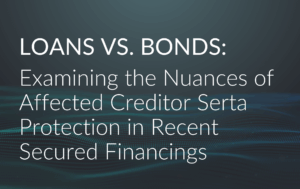
Warner Bros. Discovery: The Last of "One WBD"
Hunter Martin, CFA - Head of Media/Cable, CreditSights
Brian McKenna - Analyst, Telecom & Media/Cable, CreditSights
Joshua Kramer - Senior Analyst, Special Situations, CreditSights
9 June 2025
Insights into Warner Bros. Discovery’s split and debt restructuring
- Strategic Rationale for the Split: Understand why WBD is separating into Global Networks and Streaming & Studios, and what each unit’s focus will be.
- Details of the Debt Tender and Consent Solicitation: Learn how WBD plans to manage its $35.5 billion in debt through aggressive tender offers and covenant changes.
- Market Reactions and Valuation Impact: See how bond and equity markets have responded to the announcement, and what it signals about investor sentiment.
- Credit Risks for Remaining Bondholders: Discover the challenges facing bondholders who retain exposure to the structurally weaker Global Networks business post-spin.
- Key Uncertainties and Disclosure Gaps: Examine the major unknowns around capital structure, financial targets, and what they mean for credit analysis and risk.
Executive Summary:
- Splitting into two companies via Studios & Streaming spin off. WBD announced this morning that it plans to separate the company, in a tax-free transaction, into two publicly traded companies: (1) Global Networks and (2) Streaming & Studios. The rationale for the separation is to “unlock value for shareholders” by allowing each company to adopt a distinct capital structure and business strategy. The separation is expected to be completed by mid-2026. While the S&S spin off is in line with our expectations, the aggressive LME-style came as a surprise.
- Cash tender offers and consent solicitations for nearly all of $35.5 billion outstanding notes. In conjunction with the plan to separate Global Networks and S&S, WBD also announced the commencement of cash tender offers and consent solicitations for substantially all of its ~$35.5 billion outstanding notes and debentures. The aggregate purchase price is up to $14.6 billion, and the offers are priced at a significant premium to WBD’s trading levels prior to the deal announcement. Given the low dollar price of WBD’s longer dated debt, we estimate WBD will capture ~$2.0-2.5 billion of discount, which equates to ~0.25x of leverage. Concurrently with the tender offers, the issuers are soliciting consents from holders of certain series of notes to to effectively remove restrictive covenants from the indentures.
- Positive bond reaction (with some exceptions) due to tender/consent premiums. WBD’s stock is up a mere ~2% at the time of publication, indicating skepticism about whether the separation will unlock the group’s sum-of-the-parts value, including the possibility of M&A activity. The bond reaction was generally more positive, albeit dependent on the tender/consent details for each specific tranche, with WBD’s 5.141% Mar-52s ~40 bp tighter (up ~3.5 points) and the EUR 4.693% May-33s ~30 bp tighter (up ~2.5 points). At the other end of the spectrum WBD’s 5.05% Mar-42s 4.279% (~70 bp wider; down ~5 points) and Mar-32s (~30 bp wider; down ~2 point) fared the worst out of the group’s benchmark issues, widening by ~20 bp (down ~1 point).
- Existing bonds will remain with the secularly challenged Linear business. The notes that remain outstanding post-tender will remain with WBD’s Global Networks (Linear) business, which is highly challenged by secular pressures. Additionally, they will rank behind an (undisclosed) amount of secured debt. This business is characterized by double-digit declines in profitability, which we expect to persist going forward. There is no question this is a high-yield business, and we are skeptical that the secured portion will be rated IG.
Splitting into two companies via Studios & Streaming spin off. Warner Bros. Discovery (WBD: Baa3/BB+/BBB-) announced this morning that it plans to separate the company, in a tax-free transaction, into two publicly traded companies: (1) Global Networks and (2) Streaming & Studious (S&S). The rationale for the separation is to “unlock value for shareholders” by allowing each company to adopt a distinct capital structure and business strategy. WBD’s President and CEO David Zaslav will serve as President and CEO of S&S, while CFO Gunnar Wiedenfels will become President and CEO of Global Networks. The separation is expected to be completed by mid-2026, with the ~12-month timeline mainly due to the need to create pro forma financials.
Cash tender offers and consent solicitations for nearly all of $35.5 billion outstanding notes. In conjunction with the plan to separate Global Networks and S&S, WBD also announced the commencement of cash tender offers and consent solicitations for substantially all of its ~$35.5 billion outstanding notes and debentures. The aggregate purchase price is up to $14.6 billion, subject to the Pool Tender Caps and Pool Tender SubCaps. The offers are priced at a significant premium to WBD’s trading levels prior to the deal announcement. Given the low dollar price of WBD’s longer dated debt, we estimate WBD will capture ~$2.0-2.5 billion of discount, which equates to ~0.25x of leverage. Concurrently with the tender offers, the issuers are soliciting consents from holders of certain series of notes to adopt certain proposed amendments to the indentures governing the notes (which we discuss below). The tenders will be funded by a committed bridge facility of $17.5 billion, which is expected to be refinanced with permanent financing at both WBD Global Networks and WBD S&S prior to the separation. This $17.5 billion equates to ~2x our forecast of WBD’s 2025 consolidated EBITDA (~$9.0 billion). Bondholders who tender but whose bonds are not accepted pursuant to various caps and limits will be offered the ability to exchange their bonds into junior lien bonds which would prime the hold-out debt (but would likely be junior to any new financing).
S&S spin off in line with our expectations, but aggressive LME-style came as a surprise. We previously viewed an S&S spin off as highly likely, so the formal announcement did not come as a surprise. However, we expected WBD to rebalance its capital structure via a more simplified framework (raise new debt at S&S, upstream to WBD via dividend and/or debt exchange, reduce outstanding bonds via tender with front-end focus). We also thought the amount of new debt raised would be notably smaller (~$8-10 billion, or ~3x S&S pro forma EBITDA). The path WBD elected (asking for exit consents, providing a junior lien, anti-coop language, etc.) is more aggressive and normally seen in stressed, HY situations rather than in IG companies.



